-
Posts
587 -
Joined
-
Last visited
Content Type
Profiles
Forums
Events
Gallery
Posts posted by MarkG
-
-
-
Yes, I need to know how many months (average) building a ship lasted in the Age of Sail...
I know it might depend on the ship's size, but let's say a frigate... or a sloop of war... something average.
It took three years to build the USS Constitution (Old Ironsides). It also took three years to build the original Constellation between when it was ordered and launched. Those were large frigates built in the 1790s.
The HMS Victory is a ship of the line. It was begun in 1759 and launched in 1765.
On the low end, the Sea Venture, one of the supply ships for Jamestown, was wrecked in Bermuda in July, 1609. The survivors stripped it and used the salvage to build two new, smaller ships - the Deliverance and the Patience. That took ten months working without a shipyard.
-
Making up these Spatula Mundani for the good Dr. Mission:
The first:
The second, has tweezer end as best as I could tell from drawing:
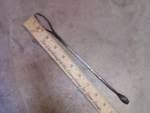
Tried to blow it up some:
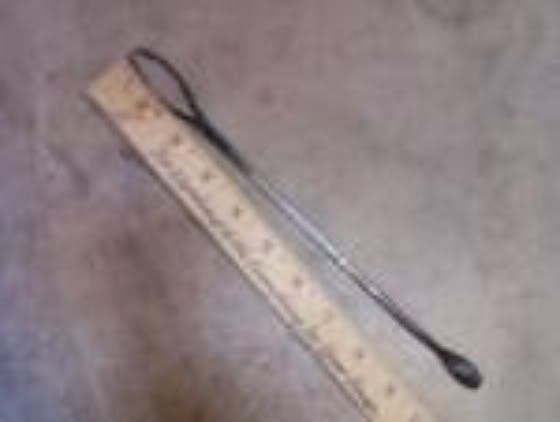
These little barnacles are actually quite fun to make!!
A few more to come as I get workshop time....
A couple of friends of mine who do early 17th century have instruments lie this. The one end is an oval and it is used for clearing the bowels. These were based on one found at Henricus Colony, a satellite colony of Jamestown in the Richmond area.
-
Wow, that arch looks really cool. I was going to tear all the lathe plaster off one of my bedroom walls and expose the brick underneath, but the cost of doing everything involved was too much, so I decided against it.
It's easier to get thin brick facings to add to walls. Our kitchen has some of those.
-
Thanks for the reply and effort, but unfortunately I am still where I was before.
The 'Slag' beer bottle, I believe to be miss-labled, they talk about the British being on the island where it was found in the 1800's
which is the 19th century, but label the glass bottle as 17th Century. It does not have any of the signs of a bottle from the 1600's
notably it does not have any sign on the bottom of where the blowing rod would have broken off as a 17th cent. bottle should have, also the top of the bottle has edges that are much too sharp and uniform for a bottle from the 17th century.
On the other hand I have seen some references that the Beleramrine (sp?) jugs, the ones with the face on them, could have been used for storing beer, but, am not sure if that is also something in error or not, you can't always trust what you read on the internet. Mostly I have seen them just referred to as holding wine. They however do fit the time period.
The Gervase Markham quote in your original link is probably the best description you are likely to find:
you shall put it into round bottles with narrow mouths, and then stopping them close with cork, set them in a cold cellar up to the waist in sand, and be sure that the corks be fast tied in with strong pack-thread, for fear of rising out, or taking vent, which is the utter spoil of the ale.Jamestown Glasshouse sells bottles like this although I don't know if they are up to holding pressurized contents. They turn them out fast and they are encouraged to make them look handmade. The onion bottles are the closest to Markham's description.
-
So going back would mean taking a nother route?
Right. At sea the wind tends to come from the same direction. You cannot sail into the wind so you either have to take a different route back or tack (sail back and forth at an angle).
The Columbus route is still the best way to sail between Europe and America. You sail south until you are even with the Canary Islands (off of Africa) then turn west and you end up in the Caribbean. From there you can either return by sailing north to Florida and catching the Gulf Stream or you can sail up the American coast most of the way.
To go to Asia from Europe, you take nearly the same route but bare south until the wind shifts from the north. By this time you are near Brazil. From there the wind will take you south and east to the tip of Africa. This was the Portuguese route. One of their ships got blown off course and made landfall on South America which is why Brazil speaks Portuguese.
This was important during the GAoP. The Spanish were downwind from Tortuga and the other pirate haunts. They were on what it known as the Windward Islands. When the wind is behind you, it makes it easier to chase down your prey. It also made reprisals harder since the Spanish would have to keep a fleet together on a long, round-about trip.
-
Interresting indeed, are also maps somewhere of the route they would plan to be taken, did they also make use of the currents? or is all the wind that makes them go?
The wind was the main propulsion but currents were important. The quickest way from the Caribbean to Europe is to take the Gulf Stream. There, the wind and currents both go the same way.
There is a theory that Ponce de Leon was trying to reach the Yucatan Peninsula and set sail directly for it but was pushed north by the currents and hit Florida instead. I have a book written in the 1990s that followed his log and that is how the current carries you. Unfortunately you end up a long way south of St. Augustine.
In clear water navigators tried to estimate currents by dropping a weighted line and seeing how far out it bowed. This was an art rather than a science.
-
There's sort of one of Jenny on this page of the first Santa Maria Surgeon's Journal.
That is better than the one I have. I will forward it to Linda.
-
Mark, does ut specifically have to be from the most recent Santa Maria event? Jessica went through her photos last night and could not find one... but I think there may be a photo(s) from previous ones... and are you looking for just cooking? Or cooking ON the ship? As we have been using park space for most of the cooking for the last few events.
It needs to be cooking on the ship. It would have to be an earlier year. Last year we cooked on shore. I have some nice pictures of that but it isn't what Linda needs.
-
Does anyone have a picture of someone cooking on the Santa Maria from a previous pirate weekend? The ship's director needs one.
-
I'll be there. May be to watch & learn.... Don't know how accurate my wooden peg is. But I'll be there.
There are all sorts of paintings and woodcuts from the 30 Years War of former soldiers with wooden legs.
If you have any links to them.....Please post.
I would love to see them......as a guide.
Here is a beggar with a wooden leg and crutches by Jacques Callot.
-
I'll be there. May be to watch & learn.... Don't know how accurate my wooden peg is. But I'll be there.
There are all sorts of paintings and woodcuts from the 30 Years War of former soldiers with wooden legs.
-
http://frontierfolk....hp?f=11&t=36257
Noticed the above item for sale... perfect for a Buccaneer impression. Great deal on a very unique musket.
Already gone.

The stock looks like it is based on the ones from Littlecote House but without the carving. That is what my carbine is based on.
-
It took Columbus around six weeks to sail from Spain to the Caribbean. The trip back was a little shorter - 28 days from the Spanish Main to Palos, Spain.
The expedition to outfit Jamestown had less favorable weather. It took them four and a half months to get from London to Virginia. That included six weeks of winter storms in the English Channel and some time spent trying to find fresh water in the Caribbean.
It took the Pilgrims a bit over to months two sail from Plymouth England to Cape Cod.
-
I have a booth at an event coming up but I've never had to set up a "period" style vendor booth before. I have a basic white pop up canopy and plenty of decorations for the tables and lots of props but need something besides the canopy for this one. Anyone know of a website that sells or rents more period style tent set ups for a vendor booth?
A lot of sutlers use tents from Panther Primitives.
-
Here's a question for someone...what does he mean here by "a great Dog?" I couldn't find an immediately acceptable definition on Google, unless it refers to one of the carpenter's tools.
“Example V.
A Concussion of the Brain. A young Lad standing in a Boat, under the Bow of the Ship, a great Dog accidentally fell from out of her, and brought his Head and the Boat’s Thwart (seat) together. He bled at the Ears and Nose, and kept doing so by Intervals for twenty-four hours; Speechless also, and insensible, yet no Wound or Appearance of Hurt through his whole Head.
I took away {ounce}xij. Of Blood immediately, had the Head shaved, and rubbed his Temples and Nostrils
__
with an equal Mixture of Sp. Lavend. and Sp. Sal. Vol. Ol.
The next Day I blooded him again, applied a large Vesicatory to his Neck, and made contemperating Julap. But this he constantly regurgitated, as often as he attempted to swallow.
On the third Day, I repeated Venesection, injected a stimulating Enema, and towards Evening he spoke; which was the first Time from his receiving the Hurt.
We daily after this, found some Progression in the Recovery; but the Stupidity wearing off slowly, I cut him an Issue, and left him to the Use of Errhines [substances that promote running at the nose], and have Reason to think they were of no small Benefit.” (Atkins, Navy Surgeon, p. 92-3)
The ratchet or pawl on a windlass is called a dog. Some of those were large and heavy enough to cause damage when dropped from a height. I don't know why one would be loose. The were a vital part of the windlass. That's the only "dog" I know of on a ship. I checked definitions and didn't see any other likely meanings.
-
Not sure if I posted these, this is the spoon I was referring to when I originally posted:
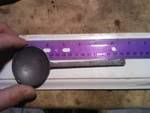
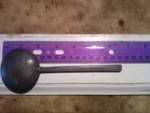
I have finished a rough mold, and will maybe try to cast tomorrow....
For some reason, I really like this spoon......go figure!
These spoons look like ones from around 1840. The style is very similar to ones in use for centuries. The main difference is the round bowl. The way to be certain is the touchmark. There should be a letter stamped on the bottom. If you look up the letter and font you will know what year it was made.
They turn up occasionally. I got four for $40 a few years ago from a dealer who should have looked up what he had.
-
Im kind of surprised... and hopefuly not jinxing anything, but so far it has been a lot of rain, and only a dusting of snow... my heart goes out to those who are snowed in.
Obviously you didn't lose power. Ours went out around 4 am. It finally came back around 4:30 pm.
-
nope, its a swivel cannon with a doglock on the side as per a request. I have tried to bridge a gap between the mounted blunderbusses and later swivel cannons to come up with an early version of something well documented.
I would put the swivel closer to the stock to make it easier to aim. I've shot a heavy matchlock with a rest and it works best with the rest foot or so forward of the touch hole. Any further and you have to move your entire body to adjust your aim. I did a bit of quick research for this message and found a nice example from a Lewis and Clark recreation.
-
Gatwick appears to be an option for some cities - the airport code is LGW. Unfortunately, Detroit isn't one of them - Travelocity threw it out. However it worked from JFK, so those of you searching may want to try it departing from your local airport.
Stansted (STN) doesn't appear to have flights coming in from the US - I couldn't get there starting in New York's JFK airport.
My daughter lives in Brighton and has used both Gatwick and Heathrow. She says to avoid Heathrow at all costs. She also advises against JFK. I think that we went to Gatwick via Atlanta last year.
Be sure to set aside at least a day for the HMS Victory and the rest of the museums at Portsmouth.
-
just finished a new wesket,waistcoat,long vest and ready to start another for Searles raid but wasn't thinking ahead enough now i'm having a hard time finding a good 16/17th century shank buttons,in the USA .like an acorn shape or anything close .Oh yes and 28 per vest =60 buttons.
A low-cost, period substitute is to use wooden beads.
-
SSSSSooooooo in my recent researching, i have run into an interesting question.......how did one act aboard ship? More clearly, how did one treat others aboard ship. What did you do when an officer spoke to you........ what did you do when the captain spoke to you, how bad was it to talk back to your superiors? How did officers address seamen......... Oh...this is on RN ships, privateers, and merchantmen...not those no good rule breaking pirates..........not asking for exact answers, just some guidance perhaps on where to look..............
Yours & co.
Isrl. Cross
Question - do you mean on a regular ship or on a pirate ship? Pirate crews were a collection of equals where the officers could be voted out of office if the crew didn't like them.
Captain Kidd's crew is an interesting case. Officially he was a pirate hunter but his crew was continually mutinous. One crewman insulted Kidd for refusing to attack a Dutch ship so Kidd hit him with a bucket. He later claimed that he hadn't realized that it was an iron bound bucket. The crewman died from the injury, contributing a charge of murder to Kidd and a verse to the song about him
"I murdered William Moore and I left him in his gore..."
Anyway, it shows that crewmen felt comfortable talking back to the captain.
-
While I don't doubt the fact that this wreck is probably that of the Queen Ann's Revenge, I seriously doubt that this is Blackbeard's sword, and even if it was, it was most likely not the one he used to fight with. With the historical accounts recording in detail the savage ferocity of the last fight that Blackbeard put up, it is highly unlikely that he would have used such a flimsy weapon. This was a type of decorative "dress" sword used by officers and gentlemen, and would not have withstood serious combat use. With that being said, the sword is beautiful none the less, and is definitely worthy of note as a relic which could indeed have come from Blackbeard's ship. It would be awesome to see it replicated...
You know, Blackbeard was not on Queen Anne's Revenge when he died. I expect that he transferred his personal effects including his weapons to the smaller ship when Queen Anne's Revenge ran aground.
Mark
-
In fact Mad Magazine did a satire on it called Bore-y Lyndon.
I so wanted to say "Bore-y Lyndon" after I saw Cascabel's response because that is exactly what it made me think of, but it seemed inappropriate. I should really see that movie instead of just relying on the satire to inform me.


 It may be a bit boring by today's standards, with not a whole lot of explosions, car chases, etc., but great costuming, a good story line, and some well researched period battle sequences, along with most scenes filmed using natural light.
It may be a bit boring by today's standards, with not a whole lot of explosions, car chases, etc., but great costuming, a good story line, and some well researched period battle sequences, along with most scenes filmed using natural light. >>>>> Cascabel
It really is more of a series of narrated illustrations than a regular movie. It looks great but very little happens in any scene.


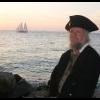

The Sack of St Augustine: Robert Searle's raid of 1668
in March
Posted
I'm planning on coming.